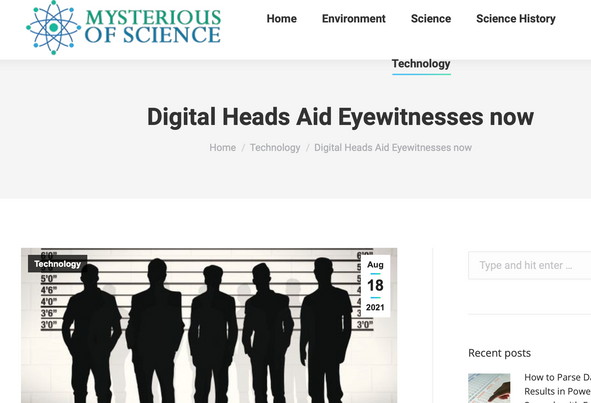Professor Heather D. Flowe
Interactive Face Identification
Accurate eyewitness identification (ID) is a cornerstone of police inquiries and national security investigations. Yet, the technology used to display lineups has not fundamentally changed over the past century. Worldwide, police present witnesses with 2D photographic lineups. But eyewitnesses often err on ID tests—analyses of real- world police identification parades reveal that witnesses quite often identify known-innocent suspects as culprits. Recently, a number of new procedures have been developed, including interactive lineups. See the figure below.
Theoretically, interactive 3D lineups overcome several problems inherent in static 2D lineups and thereby increase discriminability, which is the ability to detect guilty from innocent suspects. First, they solve the problem of viewpoint dependence. Recognition accuracy depends on the extent to which the test faces match the viewpoint in which a face was studied. At a 30-degree study-test difference, face recognition performance declines, and at 45 degrees, it is impaired significantly (Bruce, 1982). Second, seeing a face from multiple angles facilitates the building of a 3D view-independent mental representation of the face (O’Toole et al., 2002). Third, the interactive system allows the user to actively explore the faces. Active exploration and interaction, as opposed to passive, static stimulation, has been found to improve performance in different cognitive domains, such as visual attention.
The video below demonstrates the different types of interactive lineup systems my colleagues and I have developed. You can also read summaries of the research in the abstracts and videos that follow. Contact me to learn more.
Can pose reinstatement improve ID accuracy?
Police around the world ask witnesses to identify criminal suspects from lineups composed of static photographs showing each lineup member facing the camera, head-on, in frontal pose. Yet, for witnesses who encoded the perpetrator in other poses (e.g., ¾ or profile view), encoding specificity predicts identification accuracy will be higher if they could reinstate perpetrator pose, and view the lineup faces in the same angle as they had encoded the perpetrator. We are testing the effects of pose reinstatement on identification accuracy, and whether witnesses would actively seek to reinstate perpetrator pose at test, if given the opportunity. The results from one of our studies is given below in the slideshow, and the pre-print paper.
Colloff, M. F., Seale-Carlisle, T. M., Karoğlu, N., Rockey, J., Smith, H. M. J., Smith, L., Maltby, J., Flowe, H. D. (2020, April 17). Enabling witnesses to reinstate perpetrator pose during a lineup test increases accuracy. https://doi.org/10.31234/osf.io/2rwgh
Research with children
Contrary to what is believed by legal practitioners, but similar to what has been found in the basic literature, identifications made by children can be reliable when appropriate metacognitive measures are used to estimate accuracy.
Winsor A. A., Flowe H. D,, Seale-Carlisle T. M., Killeen, I. M., Hett, D,, Jores T., Ingham, M,, Lee, B. P., Stevens, L. M., Colloff, M. F. Child witness expressions of certainty are informative. J Experimental Psychology General, 150(11):2387-2407. doi: 10.1037/xge0001049.
Can face matching performance be enhanced through interactivity?
Photo-ID is necessary for identity verification in a range of settings, from crossing borders to buying age-restricted goods and accessing services. However, despite the wide use of photo-ID, face-matching is alarmingly error-prone. We are investigating whether an interactive face matching procedure can improve the performance of both ‘normal’ face recognisers and ‘superior’ face recognisers. Results from this programme of research are presented in the slideshow, and in the pre-print below.
Smith, H. M. J., Andrews, S., Baguley, T. S., Colloff, M. F., Davis, J. P., White, D. & Flowe, H. D. (In press). Performance of typical and superior face recognisers on a novel interactive face matching procedure. British Journal of Psychology. Pre-print doi: 10.31234/osf.io/kbm2g
Can interactive Lineups Reduce Own Race Bias?
People are less able to accurately perceive and remember faces that are of a race different to their own, a phenomenon known as own race bias (ORB). The causal mechanisms behind ORB have been attributed to both cognitive and social processes at encoding. To date, ORB has been predominately tested using static photographs of people shown head on, in frontal pose. Hence, it is unknown whether the ability to actively explore a face to view it in other poses would enhance memory retrieval. We are using an eyewitness memory paradigm to test whether an interactive lineup procedure that allows participant witnesses to rotate and view the lineup faces in any pose (e.g., profile, ¾ view) increases discrimination accuracy, especially for cross-race witnesses. The results are presented in the slideshow and pre-print paper below.
Colloff, M. F., Flowe, H. D., Smith, H. J., *Seale-Carlisle, T. M., Meissner, C. A., Rockey, J. C., Pande, B., Kujur, P., Parveen, N., Chandel, P., Singh, M. M., Pradhan, & S., Parganiha, A. (In press). Active exploration of faces in police lineups increases discrimination accuracy for own- and other- race faces. American Psychologist.
This work was funded by the Arnold Foundation.










